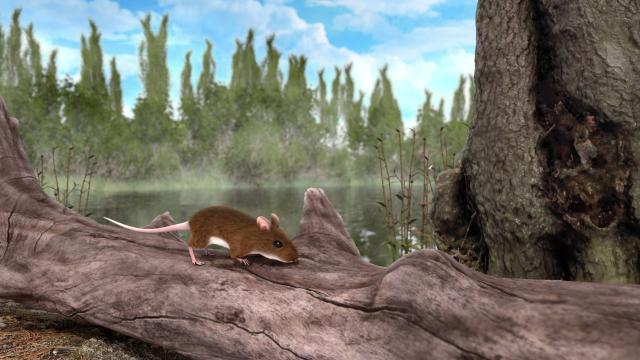Some 3 million years ago, a tiny mouse featuring reddish fur on its back and a white belly scurried across the landscape of what is now Germany. We know this thanks to a remarkable new breakthrough in which reddish colour pigment was detected in an ancient fossil—a scientific first.
Fossils with traces of soft tissue are exceptionally rare, making it difficult—if not impossible—for scientists to determine the colour of a specimen, the texture of its skin, and other important cosmetic and functional characteristics. Without this information, scientists can’t be sure when certain physical features emerged in a species, and how it evolved over time.
New research published Tuesday in Nature Communications describes a new technique in which scientists, for the very first time, were able to detect reddish colour pigment in a 3 million year old mouse fossil. Using x-ray spectrography, chemical imaging, and other techniques, researchers from the University of Manchester and several other institutions showed that the extinct field mouse had reddish to brown fur on its back and a white belly. Excitingly, the new technique could be used to detect reddish colour on other fossils retaining traces of soft tissue.
“The fossils we have studied have the vast potential to unlock many secrets of the original organism. We can reconstruct key facets from life, death and the subsequent events impacting preservation before and after burial,” said Phil Manning, the lead palaeontologist on the paper and a professor at UM, in a press release.
“To unpick this complicated fossil chemical archive requires an interdisciplinary team to combine their efforts to crack this problem.”
Indeed, the new study called for experts in physics, palaeontology, and chemistry according to Manning. A key challenge was to develop a new technique for discerning red colour pigments in an ancient fossil. To do so, the researchers had to map the chemical elements associated with the pigment melanin—the dominant pigment in animals. For the colour red, the version of melanin is pheomelanin, and for the colour black it’s eumelanin. In fossils, the red pigment is rarer and more difficult to detect, as it’s less stable over vast time scales.
Prior to the new study, scientists had already developed a technique for detecting eumelanin in ancient fossils. This was done, for example, to show that archaeopteryx, an early bird-like dinosaur, had similar approach to show that some dinosaurs had lighter colouring on their undersides and darker colouring on top—a form of camouflage known as countershading.
Three years ago, Nick Edwards, a co-author of the new study and a scientist at SLAC National Accelerator Laboratory, showed that it was possible to distinguish eumelanin pigments from pheomelanin pigments in modern birds, a discovery that established important groundwork for the new study.
“We had to build up a strong foundation using modern animal tissue before we could apply the technique to these ancient animals,” said Edwards in a SLAC statement. “It was really a tipping point in using chemical signatures to crack the colouring of ancient animals with soft tissue fossils.”
For the new analysis, the researchers used an extraordinary 3 million-year-old fossil of an extinct field mouse found near the German village of Willershausen. The fossil, dubbed “mighty mouse”, was blasted by X-ray radiation at the Stanford Synchrotron Radiation Lightsource and at Diamond Light Source in the United Kingdom. This allowed the researchers to study the interactions of X-rays with the chemistry of the fossil. The trick was to spot the trace metals that were once present in the soft tissues of the living organisms.
“Where once we saw simply minerals, now we gently unpick the ‘biochemical ghosts’ of long extinct species,” said Manning.
Observations showed that the trace metals in the fossil bonded with the organic chemicals in the same way it does in living creatures with high concentrations of red pigment in their tissue. This resulted in the identification of pheomelanin in the fossilized mouse fur.
“Finding countershading in a 3 million year old mouse is neat and shows how modern analytical techniques can reveal important information that traditional study approaches would probably have missed,” Michael Pittman, a palaeontologist at the University of Hong Kong who wasn’t involved with the new study, told Gizmodo.
Pittman said his own work in developing Laser Stimulated Fluorescence imaging is similar in this regard, which he used to reveal the first example of countershading in dinosaurs.
Excitingly, this new, non-destructive technique could be used to study other fossils.
“Resolution of pheomelanin pigment residue should now be possible, using a combination of chemical imaging and X-ray spectroscopy, at least for specimens with an age equal to or less than 3 million years,” the authors wrote in the new study.
Hopefully these future efforts will continue to add colour to what was once a monochrome past.
